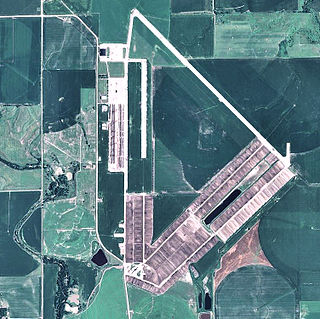
Bruning Army Air Field was a flight training installation of the United States Army Air Forces used during World War II and located in northeast Thayer County, Nebraska, at coordinates 40°20'25" North, 97°25'42" West, approximately six miles east of Bruning.

McCook Army Airfield was activated on 1 April 1943. It is located nine miles (14 km) northwest of McCook, a city in Red Willow County, Nebraska, United States and is southwest of North Platte, Nebraska. It was constructed in 1943. The 2,100-acre (8.5 km2) site is bordered on all sides by level farm ground.

Fairmont State Airfield is three miles south of Fairmont, in Fillmore County, Nebraska. The National Plan of Integrated Airport Systems for 2011–2015 categorized it as a general aviation facility. It has no scheduled airline service.

Harvard State Airport is two miles northeast of Harvard, in Clay County, Nebraska. It has no airline flights.

The 449th Air Expeditionary Group is a provisional United States Air Force unit assigned to the Third Air Force supporting United States Africa Command. It is stationed at Camp Lemonnier, Djibouti. It flies missions for Africa Command and Combined Joint Task Force – Horn of Africa, supporting varied U.S. objectives in the area.

The 468th Bombardment Group was a World War II United States Army Air Forces combat organization. The unit served primarily in the Pacific Ocean theater and China Burma India Theater of World War II as part of Twentieth Air Force. The 468th Bomb Group's aircraft engaged in very heavy bombardment Boeing B-29 Superfortress operations against Japan. After its reassignment to the Mariana Islands in 1945, its aircraft were identified by a "I" and a triangle painted on the tail. It was inactivated on 31 March 1946.

The 504th Bombardment Group was a World War II United States Army Air Forces combat organization.

The 29th Flying Training Wing is an inactive United States Air Force unit last based at Craig Air Force Base, Alabama. It was inactivated when Craig was closed when the Air Force reduced its pilot training program after the Vietnam War.

The 502d Bombardment Group was a World War II Army Air Forces (AAF) strategic bombardment organization. The unit was one of the last few combat groups formed by the AAF, activating on 1 June 1944. After nearly a year training with Boeing B-29 Superfortress, it moved to Guam in April 1945. It flew its first combat mission on 30 June 1945 and its first strike on the Japanese home islands in July. It was awarded the Distinguished Unit Citation for attacks on the Japanese oil industry between 5 August and 15 August 1945. After V-J Day it flew show of force missions and evacuated prisoners of war. It remained in the Pacific until it was inactivated on 15 April 1946.

The 346th Bombardment Group is a former United States Army Air Forces unit. It was last assigned to the 316th Bombardment Wing at Kadena Airfield, Okinawa, where it was inactivated on 30 June 1946. The group was originally a heavy bomber training unit, but was inactivated in a general reorganization of Army Air Forces training units in 1944. It was reorganized as a Boeing B-29 Superfortress group later that year. It moved to Okinawa in 1945, but arrived too late to participate in combat.
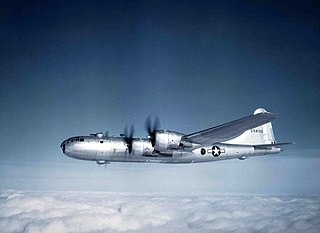
The 382d Bombardment Group is a former United States Army Air Forces unit. It was last stationed at Camp Anza, California, where it was inactivated on 4 January 1946. The group was active from 1942 to 1944 as a heavy bomber training unit. It was reorganized as a very heavy bomber unit and trained for deployment overseas. However, it arrived at its overseas station too late to see combat, and returned to the United States, where it was inactivated.

The 313th Air Division is an inactive United States Air Force unit. It was initially organized in 1944 during World War II for use in the Pacific Theater of Operations. Its last assignment was with Pacific Air Forces at Kadena Air Base, Okinawa. It was inactivated on 1 October 1991.
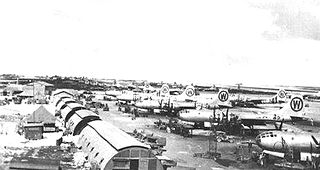
The 505th Bombardment Group is an inactive United States Air Force unit. Its last assignment was with Thirteenth Air Force, stationed at Clark Field, Philippines. It was inactivated on 30 June 1946.

The 768th Bombardment Squadron is an inactive United States Air Force unit. It was last assigned to the 462d Strategic Aerospace Wing at Larson Air Force Base, Washington, where it was inactivated on 25 June 1966. The squadron was first activated in 1943, and became one of the earliest Boeing B-29 Superfortress units. It moved to the China Burma India Theater in April 1944 and participated in the first attack on the Japanese Home Islands since the 1942 Doolittle Raid on 15 June 1944. It earned three Distinguished Unit Citations. The squadron moved to Tinian with the rest of the 58th Bombardment Wing in April 1945 and continued its participation in the strategic bombing campaign against Japan until V-J Day. In November 1945, it returned to the United States, where it was inactivated in April 1946.

The 28th Operations Group is the flying component of the United States Air Force 28th Bomb Wing, stationed at Ellsworth Air Force Base, South Dakota.
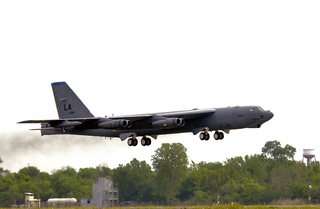
The 340th Weapons Squadron is a United States Air Force unit assigned to the USAF Weapons School. It is stationed at Barksdale Air Force Base, Louisiana. The 340th is assigned to the 57th Wing, at Nellis Air Force Base, Nevada. The mission of the squadron is to provide Boeing B-52 Stratofortress instructional flying.

The 718th Bombardment Squadron is an inactive United States Air Force unit. It was last assigned to the 4128th Strategic Wing at Amarillo Air Force Base, Texas, where it was inactivated on 1 February 1963.

The 717th Bombardment Squadron is an inactive United States Air Force unit. It was last assigned to the 4245th Strategic Wing at Sheppard Air Force Base, Texas, where it was inactivated on 1 February 1963.

The 716th Bombardment Squadron is an inactive United States Air Force unit. It was last assigned to the 449th Bombardment Wing at Kincheloe Air Force Base, Michigan, where it was inactivated on 30 September 1977.
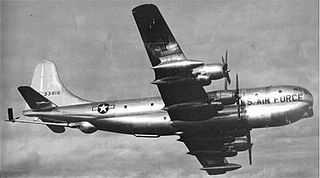
The 303rd Air Refueling Squadron is an inactive United States Air Force unit. It was last assigned to the 499th Air Refueling Wing at Kindley AFB, Bermuda, where it was inactivated on 15 June 1963.






















